Effects of Machining Parameters and Tool Reconditioning on Cutting Force, Tool Wear, Surface Roughness and Burr Formation in Nickel-Based Alloy Milling
Abstract
:1. Introduction
2. Methodology
2.1. Experimental Setup
2.2. Material
2.3. Cutting Tool
2.4. Applied Technological Parameters for 1st Experiment Row
2.5. Applied Technological Parameters and Trochoidal Strategies for 2nd Experiment Row
3. Results
3.1. Results from 1st Experiment
3.1.1. Cutting Force
3.1.2. Surface Roughness
3.1.3. The Goodness of Tool Reconditioning
3.2. Results from 2nd Experiment
3.2.1. Cutting Force
3.2.2. Average Surface Roughness Evaluation in the Second Experiment
3.2.3. Tool Wear
3.2.4. Burr Formation on Machined Edges
4. Conclusions
- The applied technological parameters have a great influence on the cutting force and average surface roughness of milled slots.
- The applied strategies have a great effect on tool life and average surface roughness due to directional changes. It is advisable to use toolpaths that ensure a constant contact angle.
- Tool reconditioning has a great influence on tool life and average surface roughness of milled slots; however, this influence is unpredictable, as seen from the goodness of tool reconditioning.
- The applied trochoidal strategy and tool reconditioning have a great influence on burr formation on the machined edge.
Author Contributions
Funding
Institutional Review Board Statement
Informed Consent Statement
Data Availability Statement
Conflicts of Interest
References
- Kónya, G.; Kovács, Z.F. The Comparison of Effects of Liquid Carbon Dioxide and Conventional Flood Cooling on the Machining Conditions During Milling of Nickel-based Superalloys. Period. Polytech. Mech. Eng. 2023, 67, 190–196. [Google Scholar] [CrossRef]
- Kónya, G.; Szabó, N.; Kovács, Z.F. Investigation of the Machinability of GTD-111 Type Nickel-Base Superalloy During Face Milling. Acta Mater. Transilv. 2023, 6, 23–28. [Google Scholar] [CrossRef]
- Guimaraes, M.C.; Fogagnolo, J.B.; Paiva, J.M.; Veldhuis, S.; Diniz, A.E. The impact of the cutting parameters and tool condition on surface integrity when milling Inconel 625. J. Mater. Res. Technol. 2023, 25, 1944–1958. [Google Scholar] [CrossRef]
- Ezugwu, E.; Bonney, J.; Yamane, Y. An overview of the machinability of aeroengine alloys. J. Am. Acad. Dermatol. Process. Technol. 2003, 134, 233–253. [Google Scholar] [CrossRef]
- Xue, K.; Chen, P.; Liu, W.; Zou, B.; Li, L.; Chen, W.; Wang, X.; Xu, Z. Geometric Structures for Sialon Ceramic Solid End Mills and Its Performance in High-Speed Milling of Nickel-Based Superalloys. Coatings 2023, 13, 1483. [Google Scholar] [CrossRef]
- Zhang, J.; Du, J.; Li, B.; Su, G. Investigation on White Layer Formation in Dry High-Speed Milling of Nickel-Based Superalloy GH4169. Machines 2023, 11, 406. [Google Scholar] [CrossRef]
- Grzesik, W.; Niesłony, P.; Habrat, W.; Sieniawski, J.; Laskowski, P. Investigation of tool wear in the turning of Inconel 718 superalloy in terms of process performance and productivity enhancement. Tribol. Int. 2018, 118, 337–346. [Google Scholar] [CrossRef]
- Zhu, D.; Zhang, X.; Ding, H. Tool wear characteristics in machining of nickel-based superalloys. Int. J. Mach. Tools Manuf. 2013, 64, 60–77. [Google Scholar] [CrossRef]
- Gonzalez, L.S.; Aguirre, F.M.; Soo, S.L.; Hood, R.; Novovic, D. Influence of Size Effect in Milling of a Single-Crystal Nickel-Based Superalloy. Micromachines 2023, 14, 313. [Google Scholar] [CrossRef]
- Ezugwu, E. Key improvements in the machining of difficult-to-cut aerospace superalloys. Int. J. Mach. Tools Manuf. 2005, 45, 1353–1367. [Google Scholar] [CrossRef]
- Molaiekiya, F.; Khoei, A.A.; Aramesh, M.; Veldhuis, S.C. Machined surface integrity of inconel 718 in high-speed dry milling using SiAlON ceramic tools. Int. J. Adv. Manuf. Technol. 2021, 112, 1941–1950. [Google Scholar] [CrossRef]
- Singh, A.; Ghosh, S.; Aravindan, S. State of art for sustainable machining of nickel-based alloys using coated and uncoated tools and machining of high strength materials using surface modified cutting tools. Tribol. Int. 2022, 170, 107517. [Google Scholar] [CrossRef]
- Kónya, G.; Kókai, E.; Kovács, Z.F. Finite Element Simulation of Face Milling during Milling of Nickel-Based Superalloys. In Proceedings of the 10th International Scientific and Expert Conference, Slavonski Brod, Croatia, 22–24 September 2022. [Google Scholar]
- Patel, T.; Khanna, N.; Yadav, S.; Shah, P.; Sarikaya, M.; Singh, D.; Gupta, M.K.; Kotkunde, N. Machinability analysis of nickel-based superalloy Nimonic 90: A comparison between wet and LCO2 as a cryogenic coolant. Int. J. Adv. Manuf. Technol. 2021, 113, 3613–3628. [Google Scholar] [CrossRef]
- Guo, C.; Chen, X.; Li, Q.; Ding, G.; Yue, H.; Zhang, J. Milling optimization of GH4169 nickel–based superalloy under minimal quantity lubrication condition based on multi-objective particle swarm optimization algorithm. Int. J. Adv. Manuf. Technol. 2022, 123, 3983–3994. [Google Scholar] [CrossRef]
- Korkmaz, M.E.; Gupta, M.K.; Boy, M.; Yaşar, N.; Krolczyk, G.M.; Günay, M. Influence of duplex jets MQL and nano-MQL cooling system on machining performance of Nimonic 80A. J. Manuf. Process. 2021, 69, 112–124. [Google Scholar] [CrossRef]
- Wang, F.; Wang, Y. Comparison of cryogenic cooling strategy effects on machinability of milling nickel-based alloy. J. Manuf. Process. 2021, 66, 623–635. [Google Scholar] [CrossRef]
- Yildrim, C.V.; Kivak, T.; Sarikaya, T.; Sirin, S. Evaluation of tool wear, surface roughness/topography and chip morphology when machining of Ni-based alloy 625 under MQL, cryogenic cooling and CryoMQL. J. Mater. Res. Technol. 2020, 9, 2019–2092. [Google Scholar]
- Pusavec, F.; Hamdi, H.; Kopac, J.; Jawahir, I. Surface integrity in cryogenic machining of nickel based alloy—Inconel 718. J. Am. Acad. Dermatol. Process. Technol. 2011, 211, 773–783. [Google Scholar] [CrossRef]
- Wu, X.; Zhu, W.; Chen, J. Tool wear mechanisms in laser-assisted milling of Nickel-based superalloys. J. Braz. Soc. Mech. Sci. Eng. 2021, 43, 151. [Google Scholar] [CrossRef]
- Zhang, H.; Yan, R.; Deng, B.; Lin, J.; Yang, M.; Peng, F. Investigation on surface integrity in laser-assisted machining of Inconel 718 based on in-situ observation. Procedia CIRP 2022, 108, 129–134. [Google Scholar] [CrossRef]
- Kun, K.; Kodácsy, J.; Vaczkó, D.; Kovács, Z.F. Machinability of Ni-based Superalloys by Indexable End Mills. Acta Mater. Transilv. 2019, 2, 49–54. [Google Scholar] [CrossRef]
- Jiang, Y.; Yue, H.; Li, Q.; Ding, G.; Wang, X. Study on the Machinability of Ni-Based Superalloy by Milling Parameters and Cooling Methods under Minimal Quantity Lubrication. Appl. Sci. 2023, 13, 2773. [Google Scholar] [CrossRef]
- Salehi, M.; Blum, M.; Fath, B.; Akyol, T.; Haas, R.; Ovtcharova, J. Epicycloidal Versus Trochoidal Milling-Comparison of Cutting Force, Tool Tip Vibration, and Machining Cycle Time. Procedia CIRP 2016, 46, 230–233. [Google Scholar] [CrossRef]
- Shixiong, W.; Wei, M.; Bin, L.; Chengyong, W. Trochoidal machining for the high-speed milling of pockets. J. Am. Acad. Dermatol. Process. Technol. 2016, 233, 29–43. [Google Scholar] [CrossRef]
- Szalóki, I.; Csuka, S.; Csesznok, S.; Sipos, S. Can trochoidal milling be ideal? In Proceedings of the XXI Conference of GTE in Manufacturing and Related Technologies, Budapest, Hungary, 14–16 November 2012. [Google Scholar]
- Rauch, M.; Duc, E.; Hascoet, J.Y. Improving trochoidal toolpaths generation and implementation using process constraints modelling. Int. J. Mach. Tools Manuf. 2009, 49, 375–383. [Google Scholar] [CrossRef]
- Jacso, A.; Matyasi, G.; Szalay, T. The fast constant engagement offsetting method for generating milling tool paths. Int. J. Adv. Manuf. Technol. 2019, 103, 4293–4305. [Google Scholar] [CrossRef]
- Jacso, A.; Matyasi, G.; Szalay, T. Trochoidal Tool Path Planning Method for Slot Milling with Constant Cutter Engagement. In Lecture Notes in Mechanical Engineering; Springer: Singapore, 2021; pp. 659–668. [Google Scholar]
- Santhakumar, J. Effect of Various Tool Path Strategies on the Performance Parameters in Milling Process. Available online: https://shodhganga.inflibnet.ac.in:8443/jspui/handle/10603/384632 (accessed on 26 September 2023).
- Syafik, J.M.; Razali, M.M.; Azwan, S.S. The Influence of Tool Geometry towards Cutting Performance in Machining Aluminium 7075. MATEC Web Conf. 2017, 97, 01079. [Google Scholar] [CrossRef]
- Karagiannis, S.; Stavropoulos, P.; Ziogas, C.; Kechagias, J. Prediction of surface roughness magnitude in computer numerical controlled end milling processes using neural networks, by considering a set of influence parameters: An aluminium alloy 5083 case study. Proc. Inst. Mech. Eng. Part B J. Eng. Manuf. 2014, 228, 233–244. [Google Scholar] [CrossRef]
- Kopac, J.; Krajnik, P. Robust design of flank milling parameters based on grey-Taguchi method. J. Mater. Process. Technol. 2007, 191, 400–403. [Google Scholar] [CrossRef]
- Kónya, G.; Kovács, Z.F.; Kókai, E. Milling of Nickel-based Superalloy by Trochoidal Strategies. In Proceedings of the 2022 IEEE 22nd International Symposium on Computational Intelligence and Informatics and 8th International Conference on Recent Achievements in Mechatronics, Automation, Computer Science and Robotics (CINTI-MACRo), Budapest, Hungary, 21–22 November 2022. [Google Scholar]
- Ahmed, F.; Ahmad, F.; Kumaran, S.T.; Danish, M.; Kurniawan, R.; Ali, S. Development of cryogenic assisted machining strategy to reduce the burr formation during micro-milling of ductile material. J. Manuf. Process. 2023, 85, 43–51. [Google Scholar] [CrossRef]
- dos Santos, A.J.; de Oliveira, D.A.; Pereira, N.F.S.; Abrão, A.M.; Rubio, J.C.C.; Câmara, M.A. Effect of Conventional and Trochoidal Milling Paths on Burr Formation during Micromilling of Grade 4 Commercially Pure Titanium. Arab. J. Sci. Eng. 2023. [Google Scholar] [CrossRef]
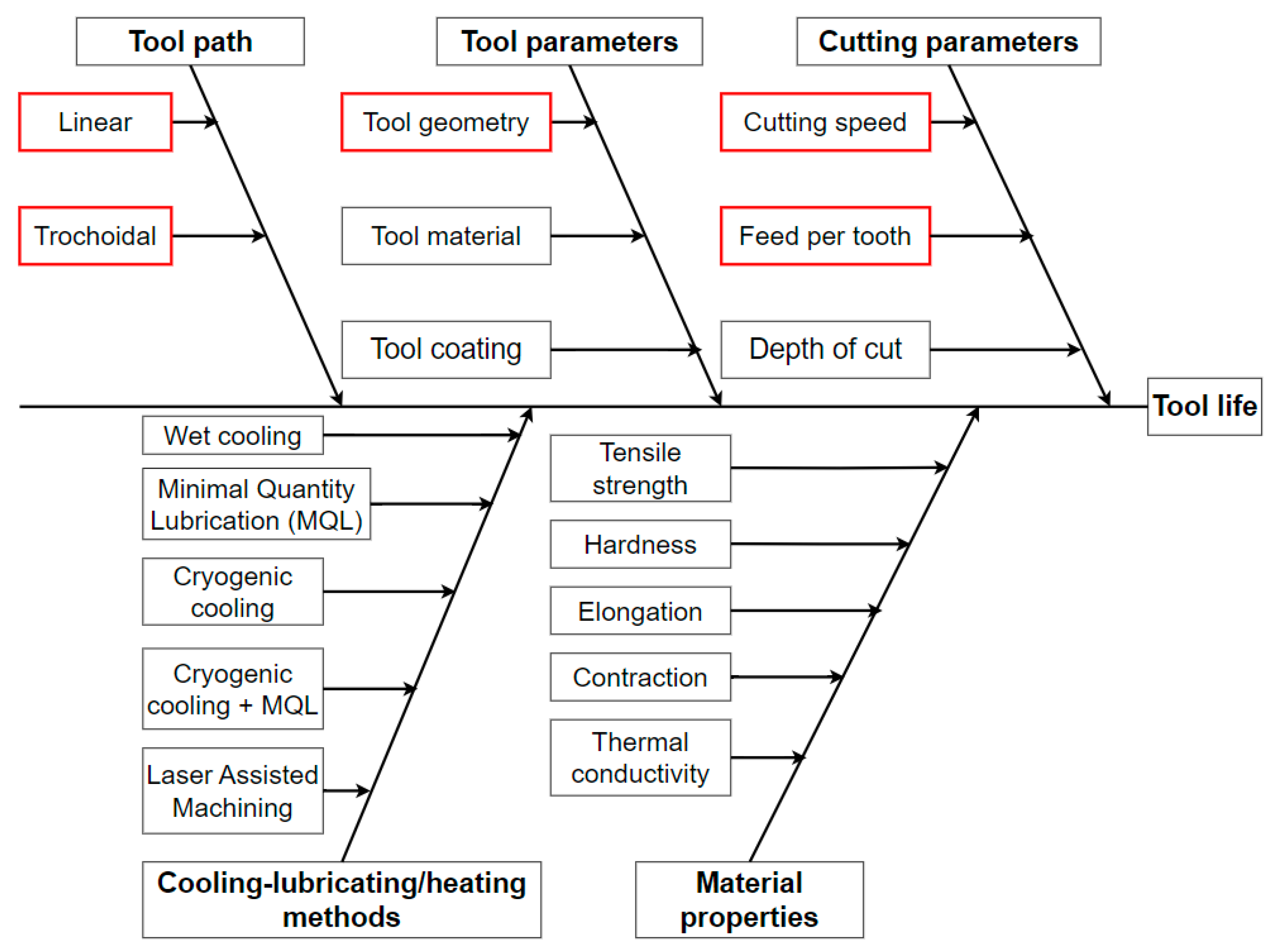



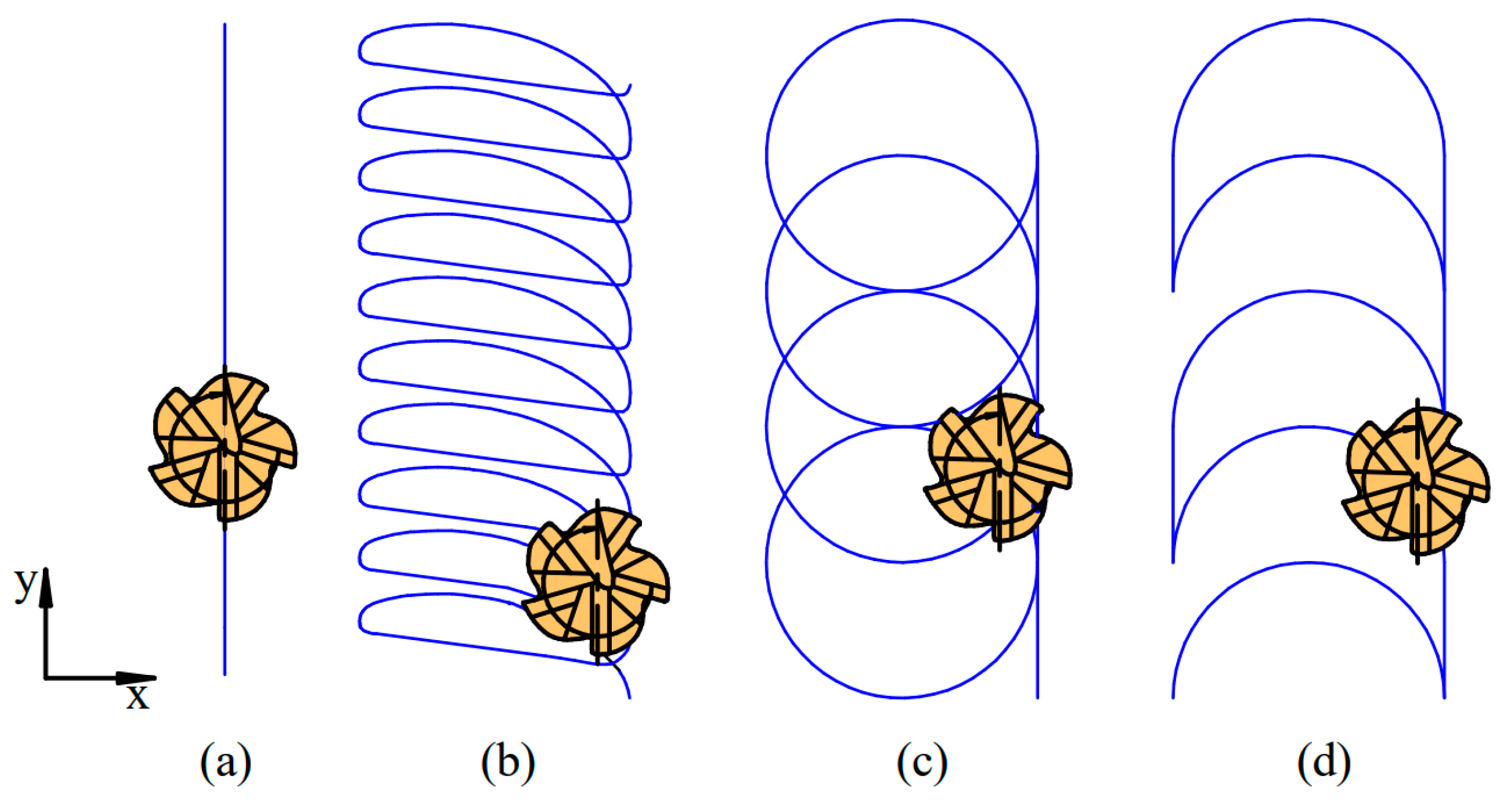

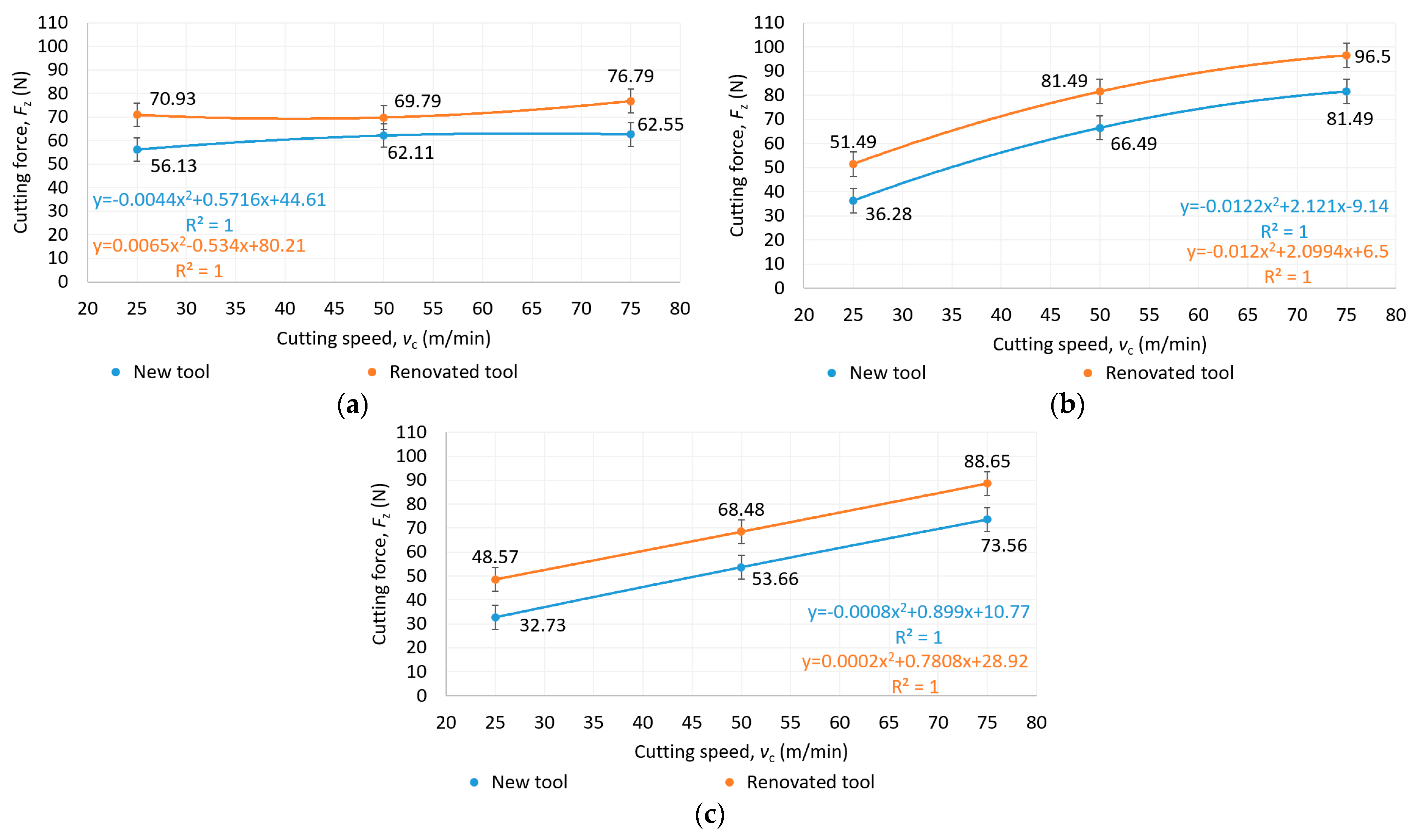
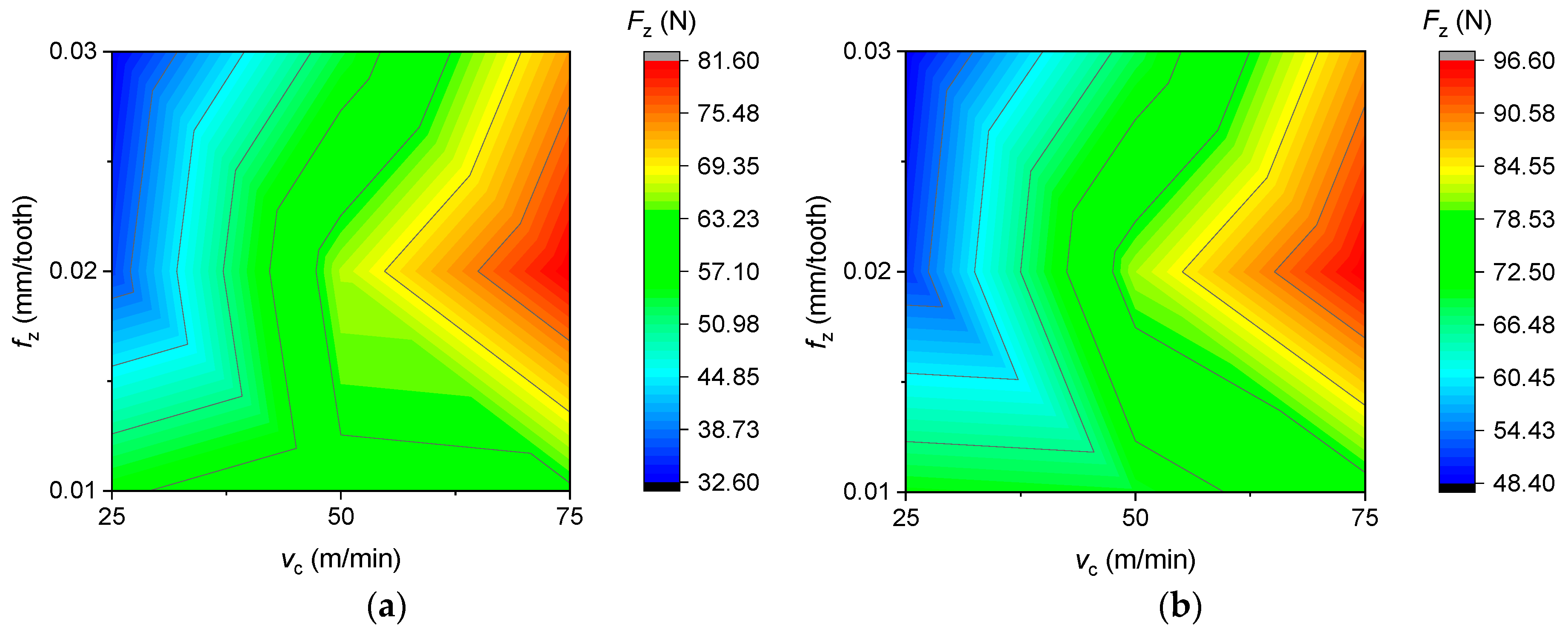


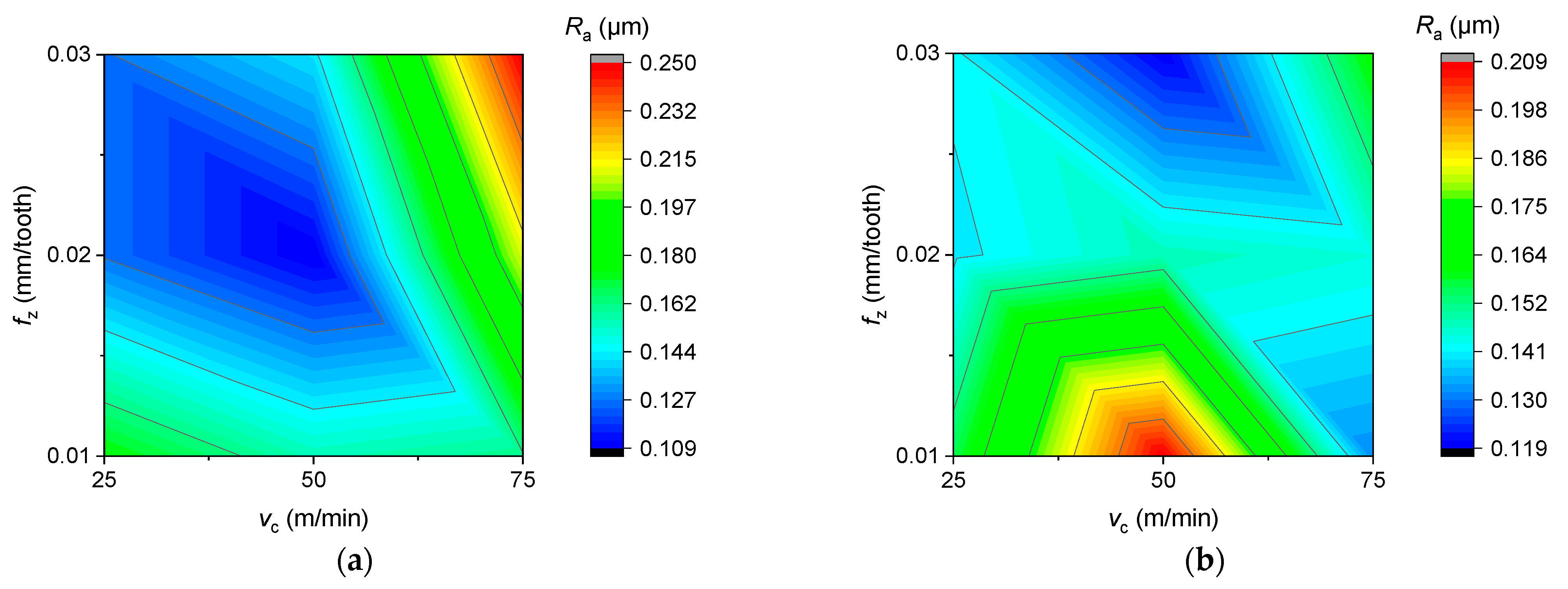
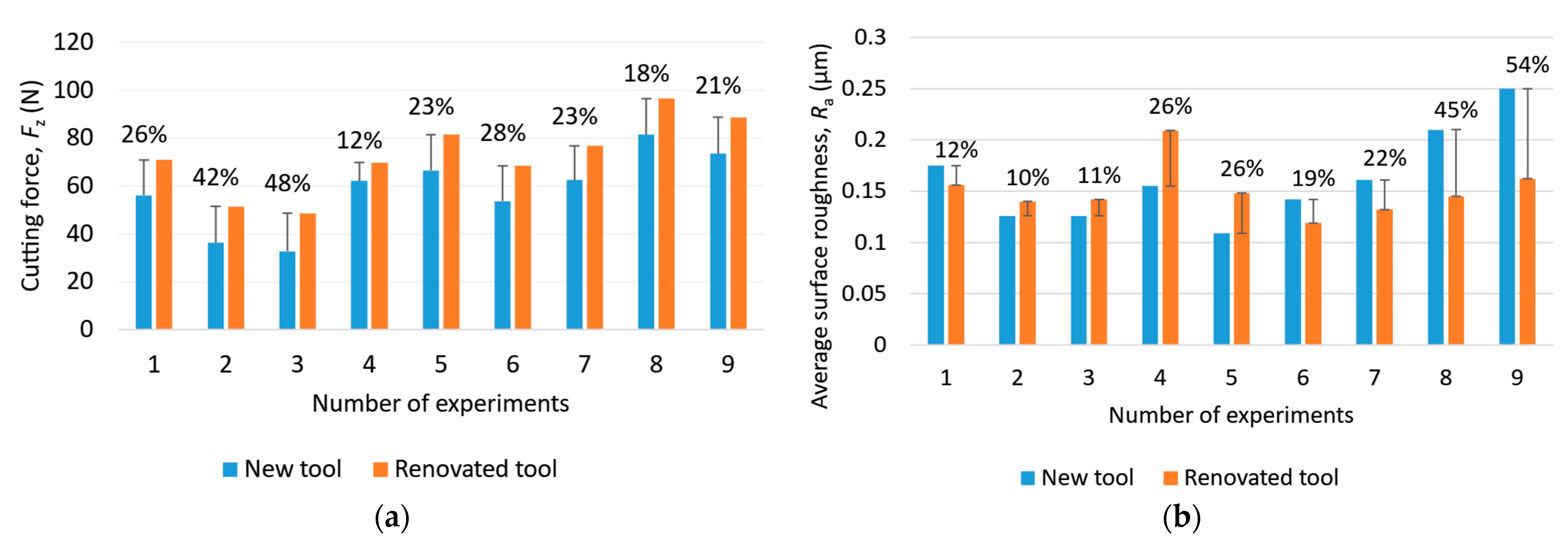

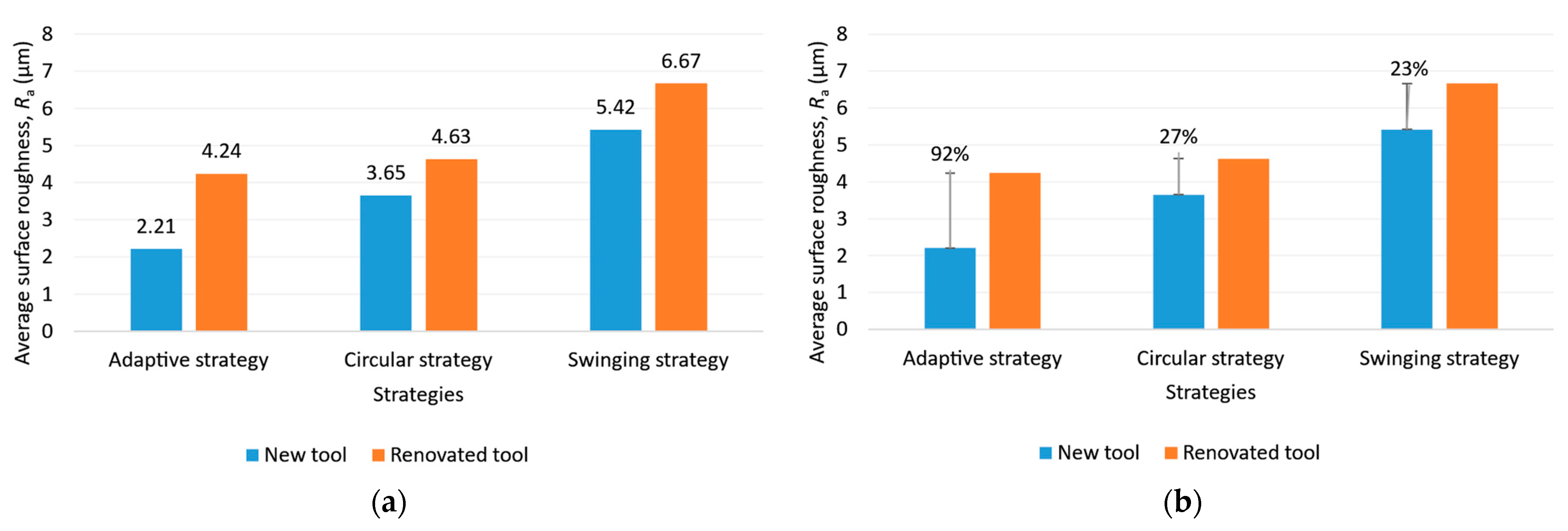
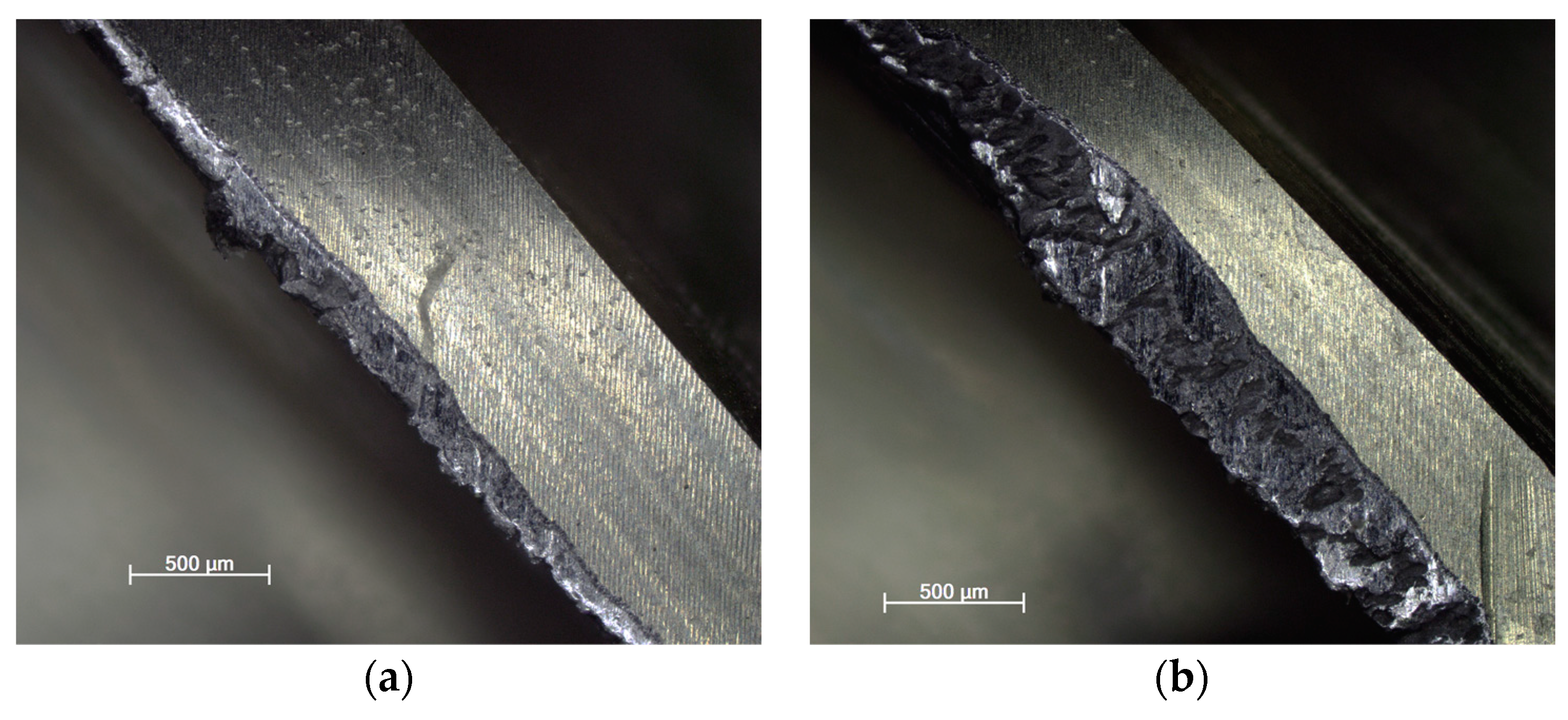

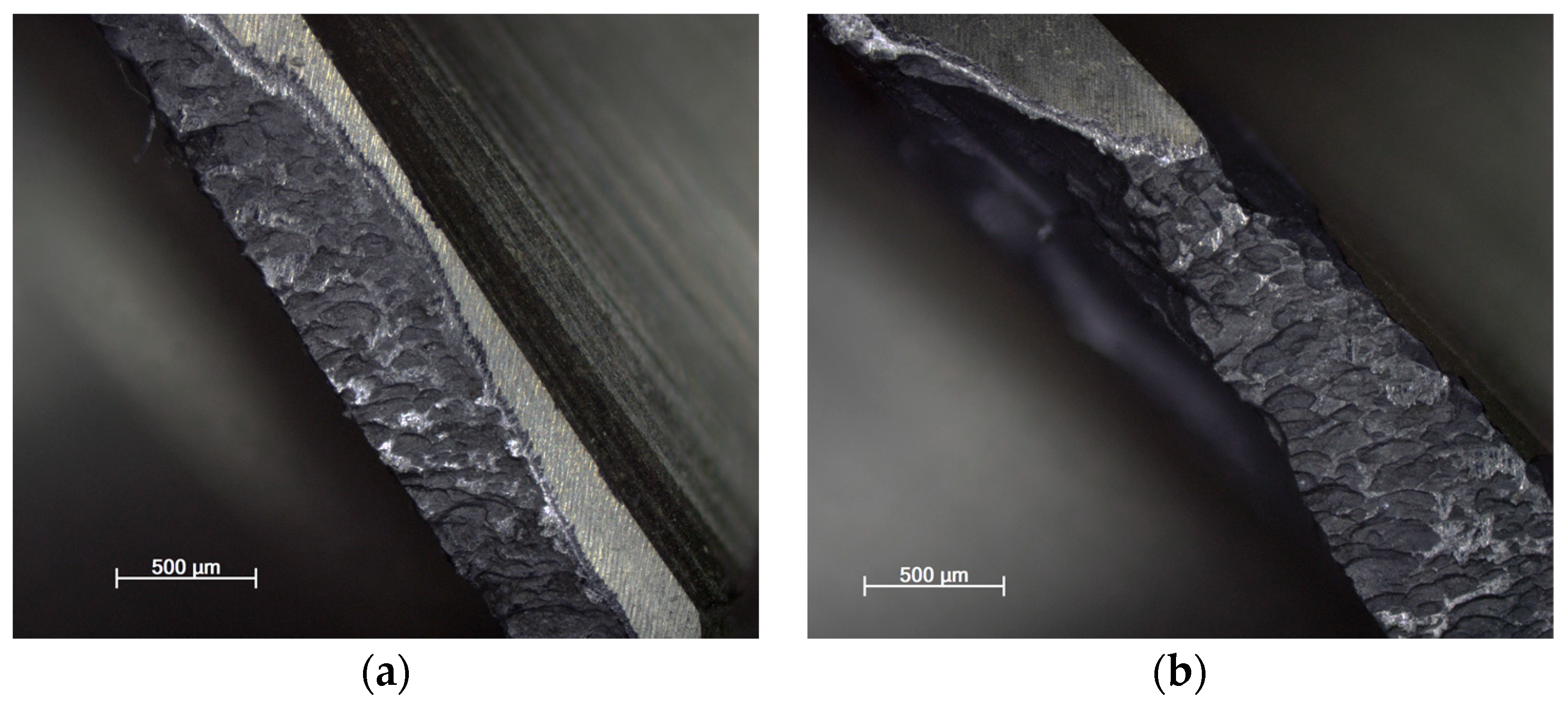
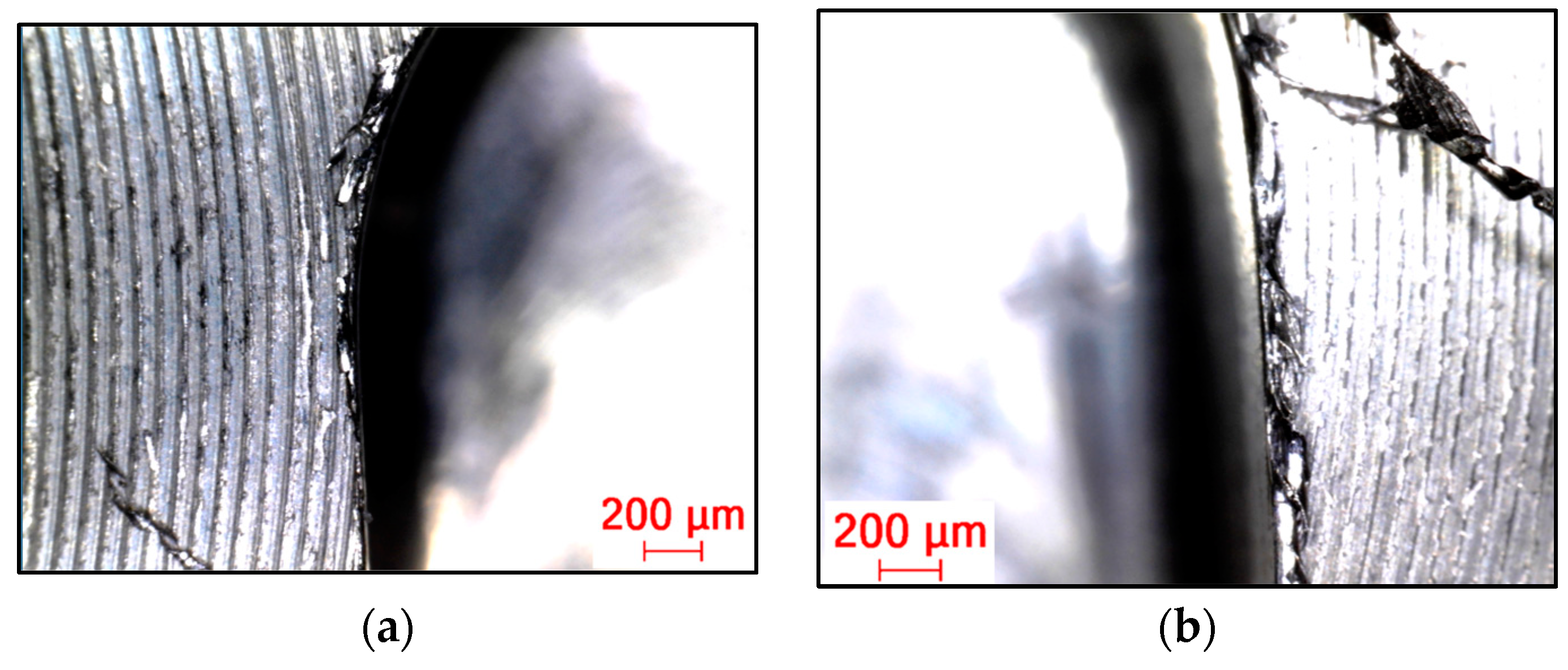
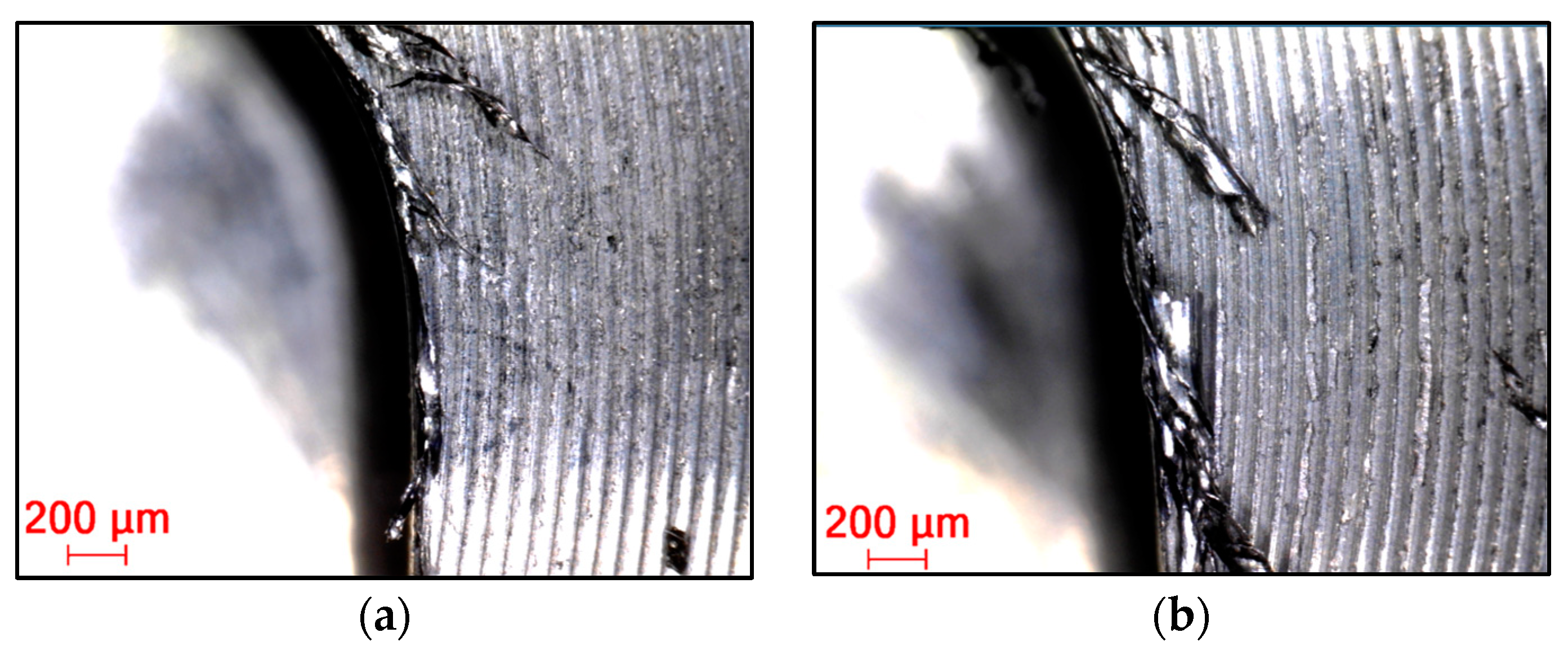

| Ni (%) | C (%) | Cr (%) | Co (%) | Al (%) | Ti (%) | W (%) | Mo (%) | Ta (%) | Zr (%) | B (%) | Hf (%) |
|---|---|---|---|---|---|---|---|---|---|---|---|
| 63.3 | 0.07 | 8.00 | 9.00 | 5.25 | 0.60 | 9.30 | 0.40 | 2.80 | 0.005 | 0.01 | 1.3 |
| Tensile Strength, Rm (MPa) | Elongation, A5 (%) | Contraction, Z (%) | Hardness, HRC |
|---|---|---|---|
| 1331 | 8 | 10 | 42.1 |
| Density ρ (kg/m3) | Thermal Conductivity λ (W/mK) | Specific Heat, c (J/kgK) |
|---|---|---|
| 8130 | 12.10 | 0.444 × 103 |
| Input Parameters | Levels | ||
|---|---|---|---|
| Cutting speed, vc (m/min) | 25 | 50 | 75 |
| Feed per tooth, fz (mm/min) | 0.01 | 0.02 | 0.03 |
| Exp. No. | vc (m/min) | fz (mm/min) |
|---|---|---|
| 1. | 25 | 0.01 |
| 2. | 25 | 0.02 |
| 3. | 25 | 0.03 |
| 4. | 50 | 0.01 |
| 5. | 50 | 0.02 |
| 6. | 50 | 0.03 |
| 7. | 75 | 0.01 |
| 8. | 75 | 0.02 |
| 9. | 75 | 0.03 |
Disclaimer/Publisher’s Note: The statements, opinions and data contained in all publications are solely those of the individual author(s) and contributor(s) and not of MDPI and/or the editor(s). MDPI and/or the editor(s) disclaim responsibility for any injury to people or property resulting from any ideas, methods, instructions or products referred to in the content. |
© 2023 by the authors. Licensee MDPI, Basel, Switzerland. This article is an open access article distributed under the terms and conditions of the Creative Commons Attribution (CC BY) license (https://creativecommons.org/licenses/by/4.0/).
Share and Cite
Kónya, G.; Kovács, Z.F. Effects of Machining Parameters and Tool Reconditioning on Cutting Force, Tool Wear, Surface Roughness and Burr Formation in Nickel-Based Alloy Milling. Materials 2023, 16, 7140. https://doi.org/10.3390/ma16227140
Kónya G, Kovács ZF. Effects of Machining Parameters and Tool Reconditioning on Cutting Force, Tool Wear, Surface Roughness and Burr Formation in Nickel-Based Alloy Milling. Materials. 2023; 16(22):7140. https://doi.org/10.3390/ma16227140
Chicago/Turabian StyleKónya, Gábor, and Zsolt F. Kovács. 2023. "Effects of Machining Parameters and Tool Reconditioning on Cutting Force, Tool Wear, Surface Roughness and Burr Formation in Nickel-Based Alloy Milling" Materials 16, no. 22: 7140. https://doi.org/10.3390/ma16227140






